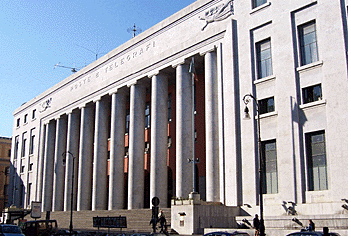...Best of Sicily presents... Best of Sicily Magazine. ... Dedicated to Sicilian art, culture, history, people, places and all things Sicilian. |
by Carlo Trabia | ||
Magazine Index Best of Sicily Arts & Culture Fashion Food & Wine History & Society About Us Travel Faqs Contact Map of Sicily |
By the late 1920s, with Fascism in full swing, Marcello Piacentini (1881-1960) became the regime's favourite architect, designing everything from railway stations to university buildings. In 1926 the "7 Group" of architects published a declaration in favour of the new style and against revivalism, effectively repudiating the Neoclassicism then in vogue in the United Kingdom and the United States, and the waning Neo-Gothic, Art Nouveau and Neo-Baroque movements. The epitome of the movement was to be EUR (Esposizione Universale Roma), planned for 1942. The war precluded this, but by 1935 construction was already under way, and today EUR, a community south of Rome, is centred around these greyish, monumental buildings. The style died a slow death. Piacentini, a card-carrying Fascist, was briefly detained but by 1946 he was again an architecture professor. (Designing ugly buildings may be considered an unattractive vocation but it is hardly a war crime.) Pier Luigi Nervi went on to design the Sports Palace used as the Olympic Stadium in 1960. EUR has sometimes been the scene for motion pictures requiring an aura of "totalitarian" or simply bizarre architectural styles. To the layman the German styles popularised during the Nazi era seem similar to Rationalism. In truth, the work of Albert Speer and others reflected stronger Neoclassical influences, but very few of Speer's buildings survive. In his biography, Speer mentions his trips to Sicily and Greece and the effect the ancient temples of Segesta and Agrigento had on his work, and on his architectural vision in general. In stark contrast, his Italian counterparts sought, successfully or not, to create something new. It's interesting to speculate that, ironically, the Germans might have come closer than the Italians to creating an urban architecture reminiscent of that of the Roman Empire whose revival Mussolini so craved. About the Author: Architect Carlo Trabia has written for this publication and others. | |
Top of Page |
 The public buildings in Palermo and Catania which resemble a hybrid
of
The public buildings in Palermo and Catania which resemble a hybrid
of